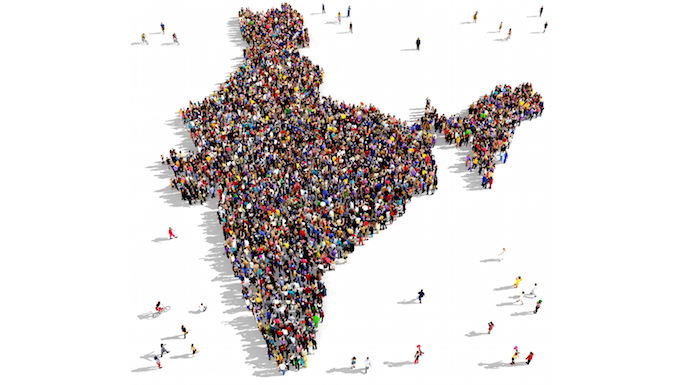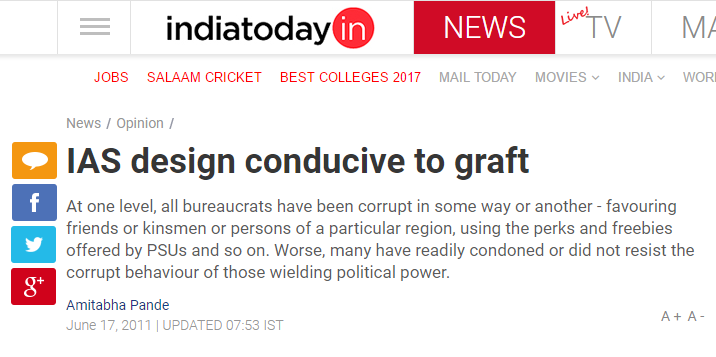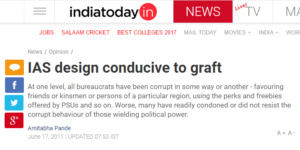The conceptual framework of Aadhaar
The state has to reach its citizens for various reasons. It needs to provide the citizens with services, and even products at times (in the form grant of physical items). It needs to provide the citizens with information and knowledge to lead a better life. Most democratic states today function as welfare states, and the functions and responsibilities entailing upon the states have seen a large increase over the last two centuries – functions that were considered purely in the private domain are now considered core responsibility of state (vaccination, for instance). In other words, the state and its citizens touch upon each other more frequently than at any other point earlier in time.
The state, therefore, needs to identity its citizens. Uniquely.
How the state identifies citizens and non-citizens
The state needs to identify its citizens to provide services. Certain services are meant even for non-citizens – rule of law, for instance. Many of the services in this latter category are in the nature of Public Goods, and citizens and non-citizens share these services in non-excludable and non-rivalrous ways. The state provides various means to identify these groups, in the form of various identity cards or inclusion in lists that provide certain benefits (BPL cards, for instance, provide access to BPL services). Because the various branches of the state provide different identity systems, most citizens usually have multiple identity documents. A minority of the absolutely disenfranchised do not have any document – citizens, and sometimes, non-citizens.
Thus, the following system existed a while back:
- Citizens and non-citizens were separate categories, who could prove their identity through different documents.
- Citizens mostly had multiple identity documents to enable them to interact with multiple branches of the state
- Some of the citizens could seldom avail services of state (except pure Public Goods), and had no identity documents. For the state, they are invisible (except, maybe, during the Census count).
With multiple documents in existence, there is a problem of duplication in access to services. Same person may avail multiple benefits from different branches of the state, although he may not be entitled. Many of these services are rivalrous – this means that a wrongful grant to someone is a wrongful denial to rightful claimant. Hence, there is a need to connect the various identity documents in such a way that wrongful inclusions are controlled. Or eradicated.
Aadhaar and unique identity
Therefore, the state has to identify its citizens uniquely. This way the state can identify which services the citizen/resident is availing from the various branches of the state. Because the state will now know each individual uniquely, it can discontinue the service wrongly availed earlier by a citizen. To take an example, a person can get two ration cards from different locations under two names (or even same name, as most ration card databases are paper-based and offline, and don’t talk to each other – there was seldom any centralised database, until recently), and take subsidised items meant for two persons when he should take only one. The difficulty in making fake or duplicate identity documents might differ, but almost all of the documents can be issued against duplicate names/identities. There was no criterion that could uniquely bind a citizen to a document in such a way that no two documents can be issued to the same citizen. This is where Aadhaar comes in.
Aadhaar provides that criterion for uniquely identifying a person by harnessing the biometrics of the person concerned. The biometrics – ten fingerprints, two iris scans, along with a headshot of the person – are taken against every person, matched against existing identifying documents provided by the person and verified in a preliminary fashion (Proof of Identity and Proof of Address documents), and then these two sets are combined together for a lifetime and beyond – after verifying that those ten fingerprints, two irises and the headshot have not been used by anyone earlier on that system. This creates a unique binary – each biological person, already identified through his PoI and PoA, is given a number that remains attached with him permanently.
Now that a unique number has been given to the person, his identity/number combination is a unique unit with which the different branches of the state interact. Aadhaar ensures that no person can have more than one number/identity attached to him. This ensures that the services do not go to duplicate identities against the same person.
However, for the benefits of Aadhaar to be reaped properly, all branches of the state must know of the Aadhaar number of the person. In this process, every service of the state in which a person is a beneficiary is attached with his Aadhaar number. This process is called Seeding.
Aadhaar and seeding
Aadhaar only provides a platform or paradigm for identity. It is not an identity card or a separate service. To remove duplicate entries from a service of the state – a process called de-duplication – it must be connected with every such service separately. This whole process is called Seeding. While the Aadhaar project was being fashioned, Seeding was presumed to be a given condition. However, various Supreme Court rulings presently make Seeding a difficult process. In the absence of Seeding, the full benefits of Aadhaar cannot be reaped.
Aadhaar and citizenship
The Aadhaar paradigm does not recognize the status of a person. It is a platform for mere identification of a person – and it does so uniquely for every person. Aadhaar does not separate the citizen from the non-citizen, the rich from the poor, the Dalit from the Brahmin, or the Kashmiri from the Bengali. These attributes are governed by other rules – legal and social. Thus, Aadhaar is not a proof of citizenship, like some other documents are – say, Voter ID or Passport. Aadhaar is given to permanent residents of India – those that have stayed for the last 182 days in India continuously. This would include all legal immigrants from all countries. Needless to add, this would also include illegal immigrants who are able to acquire supporting documents for being legally in India for the concerned period – however, the element of fraud can exist in any system or identification system to an extent. Aadhaar cannot be given to Indian citizens who have been away from India for the last 182 days – like the NRIs. Aadhaar is meant for residents of India, and whole Aadhaar ecosystem uses the term ‘resident’ for its clients/customers.
Thus, Aadhaar and citizenship are separate concepts. However, Aadhaar can be used to create a robust list of citizens. Presently, there is no such list of citizens with the state. Once that list is seeded with Aadhaar, it can be de-duplicated to create a clean list. How one is identified to be a citizen is a separate process, and Aadhaar comes into the picture only after such identification has taken place. Presently, such Aadhaar-based list is being prepared in only the State of Assam in its National Population Register. Rife with political controversies, NPR has not been undertaken in other states. In Assam also, the process is mainly being pushed by the Supreme Court.
The uses of Aadhaar
Aadhaar is seldom the basis of selection of a benefit being given by the state. Once identified to be a beneficiary, Aadhaar conclusively proves such a person, and authenticates him where required. When a beneficiary list is de-duplicated, it ensures that no person takes more than one unit of benefit, unless so permitted. In the present environment, de-duplication is the most major benefit of Aadhaar.
While the issue of seeding is embroiled in legal troubles, the Aadhaar-seeded separated databases cannot be connected. If and when Aadhaar-linked databases are connected, it can provide a lot of data and analyses on the use of the benefits. It can even provide awareness of wrongful drawal of benefits by some. For instance, a car owner cannot be in a BPL list. However, if both the BPL list and the car registration list are seeded with Aadhaar, the system can tell us which car owners are wrongly included in the BPL list – and they can be removed. This level of data-sharing is presently not allowed. However, it is possible to foresee a time in the future when various databases would become connected.
Aadhaar can also be used for Authentication. Aadhaar is a number which is tagged against certain information captured during the enrolment process – the biometrics, PoI and PoA of the resident. Thus, the Aadhaar number and any authenticating biometric (say, a fingerprint scan) may provide the underlying data and prove the identity of the person to the satisfaction of a person providing a service. This reduces the cost and time of verification, and improves the quality of data collection for a service provision (since the data comes verified by a govt. process). Given that this authentication process can also be availed of by private persons, authentication shall be a major application of Aadhaar. For instance, the mobile operator Jio used only Aadhaar based authentication for doing KYC for enrolling subscribers on their mobile platform.
Aadhaar and privacy
The state interacts with its citizens. And Aadhaar as an identity platform helps the state in making fruitful interactions. The frequency and quantum of interaction on the Aadhaar platform will tremendously increase in the future. Although the linking of databases presently faces a legal hurdle, it is realistic to expect that the benefits would outweigh the costs, and may inspire a change in the legal position. This interlinking of databases would enable to the state to know a complete picture of its interaction with a unique individual – compiled from all the branches of the state. This is a possible avenue of the loss of privacy of the individual. However, the scope of this apparent loss of privacy would depend upon a few factors:
- What transactions are recorded and for what period.
- Whether databases of various branches of the state are linked.
- What the state intends to do with the analysis of this data.
While the loss of privacy in a post-Aadhaar world is a valid concern, it must be contextualised with the loss of privacy in a hyper-connected world where each of our action leaves tell-tale digital footprints that is saved for eternity and shared for an auctioned price.
Aadhaar and federal relations
Aadhaar was borne of a Central resolution, and later backed up by a Central Act. It is funded by the Consolidated Fund of India, and partly through user charges and fees from the private entities in the Aadhaar ecosystem. The Aadhaar Act makes the use of Aadhaar mandatory for programs and schemes wherein expenditure is borne by the Centre. Many of the schemes are partly funded by the Centre – there is a legal argument borne by precedent that those partly-funded schemes can also make Aadhaar mandatory for participation. Further, many of the schemes by the State governments are also using Aadhaar, either for ensuring identity or even as a precondition for receipt of benefit. Additionally, even private entities are also harnessing the Aadhaar platform for authentication and related application.
Thus, Aadhaar provides a very interesting case wherein the federal relations between the Centres and the states are tested. The case of federal disharmony is more glaring in those cases where parties of different ideologies are governing in the states. West Bengal, for instance, has frequently raised concerns regarding the implementation of the Aadhaar and schemes harnessing it.
Aadhaar and the future
Aadhaar was born in 2010. From concept to implementation took a very short time, atypical of government projects – it helped that it was initially led by a superstar of private industry Sh. Nandan Nilekani, who inspired a start-up culture in the Aadhaar organisation, called UIDAI. Aadhaar has inspired political opposition in the initial days, but has seen a greater consensus lately and has come to be accepted as an identity platform. Being a powerful tool, it is being used or sought to be used by different branches of the state, with notifications coming out on a daily basis. It is a fast changing field where the possibilities of use and probabilities of abuse are great.




 If you are reading this, chances are you are an adult. In which case your Aadhaar enrollment process is very different from that of a child below five years of age. Children of this age group (and there is no lower age limit – a baby can be enrolled as soon as it is born) are enrolled through a much shorter process. The following are the salient features of this process:
If you are reading this, chances are you are an adult. In which case your Aadhaar enrollment process is very different from that of a child below five years of age. Children of this age group (and there is no lower age limit – a baby can be enrolled as soon as it is born) are enrolled through a much shorter process. The following are the salient features of this process: